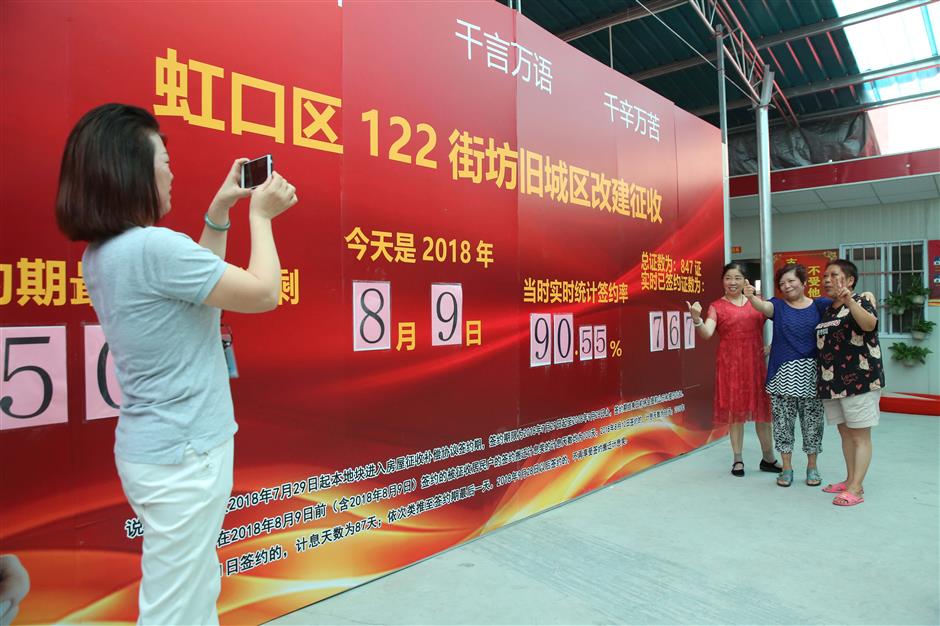Last residents to leave Hongzhen Old Street

Residents pose for a picture after signing on the agreements to move out of Hongzhen Old Street to make way for a project to revamp the dated neighborhood.
The last batch of residents at the Hongzhen Old Street in Hongkou District have agreed to be relocated, marking a milestone for the overall upgrading of the largest remaining slum in Shanghai.
Over 90 percent of the residents at the 122 block of the old residential area have eagerly signed to be relocated with great relish. They can receive either subsidies from the government or new apartments elsewhere in the city.
The street and its surrounding area once housed more than 100,000 people. Most residents still used chamber pots since they didn't have toilets and plumbing and they cooked outdoor with charcoal stoves. Residents had to line up each morning to clean their chamber pots. The the rainy season or typhoon season, they placed buckets and barrelys under the many leaks.
Earlier this month, many residents gathered at the relocation office at the block where many of them have spent half of their lives to celebrate their move. Bulldozers will tear down the remaining apartments at the Hongzhen Old Street area soon and the shabby homes will be replaced with a high-end residential community.
"We have dreamed all our life of getting out of this place," said Zhou Lanfeng, a 67-year-old resident who has lived in the area for over six decades.
Her family of five lived in a 17-square-meter apartment at the block. The crammed room is divided into a bedroom, a sitting room and a kitchen. She built a loft on the second floor a decade ago to improve the living space.
Before the relocation campaign was launched, she lived with her ill father since she could not afford an apartment of her own because of Shanghai's high prices.
"I felt I could never leave the shabby lane after the death of my mother and husband," Zhou said.
The Hongkou district government launched the relocation campaign on March 15 after neighboring parts of the area were revamped in previous years. Nearly all of the last batch of 1,201 households agreed to be relocated as soon as the government asked.
But agreeing on compensation was difficult, said Lu Xuebin, an official in charge of the relocation campaign for the area in Jiaxing Road Subdistrict.
Nearly half of the properties are jointly owned by different family members, making it difficult to reach an agreement among them. One of the apartments, for instance, was owned by 19 people.
To solve the problem, the subdistrict established three work groups to visit and talk with each member in a household. Senior residents and retired judges were invited to join the work groups to solve problems and mediate family disputes.
"For the property owned by 19 family members, we spent half a month to gather them to a meeting together," said Chen Li, another official in charge of the relocation project. With the efforts of the work group, the household finally reach an agreement among the property owners and signed to get relocated, Chen said.
The Hongzhen Old Street area originated from the Hong'an ancient town and became prosperous in early Qing Dynasty (1644-1911). The 500-meter-long street became a popular market among locals.
In the 1930s, the area was an idyllic water town with farmlands, villages and stores along with dairy and silk plants. A large number of farmers mainly from neighboring Jiangsu Province who lost their lands during the War of Resistance Against Japanese Aggression (1931-45) fled to the city and settled in straw houses on both sides of the street.
The area has been undergoing a major revamping with residential high-rise buildings, upscale shopping malls and facilities such as supermarkets, restaurants and schools. As part of a central commercial project, Ruihong Tiandi (Hall of The Moons) opened to the public and has become a popular recreation site for nearby residents and white-collars to shop, dine and spend weekends.
The former resident Zhou chose to receive cash subsidies as part of the relocation campaign. She plans to buy a small apartment in the surrounding area to live with her 90-year-old father.
"My father has been looking forward for half of his life to move into a modern residential apartment, and the dream has now come true soon," Zhou said.
















